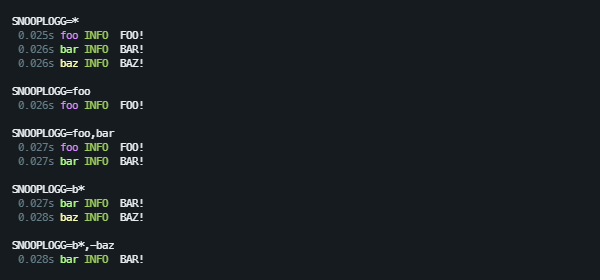
SnoopLogg is a lightweight, zero dependency debug logging library for Node.js, Bun, and Deno. It is specifically designed for CLI programs, daemons, and libraries.
What separates SnoopLogg from other loggers is the ability to 'snoop' on other log instances. Instead of passing the logger around, create a single top-level logger, tell it to snoop, then create as many new loggers as you want and the top-level logger will relay them all.
Real talk. SnoopLogg is dope, but it's not the best solution for things such as logging HTTP server requests and web browser console is not supported (yet). For CLI apps and libaries, SnoopLogg is the shiz.
Features
- Snoop on other SnoopLogg instances to aggregate log messages
- Pipe log messages to one or more streams (such as a file or socket)
- Namespaced and nested namespaced loggers
- Filter messages by namespace or log level
- Automatic namespace colorization
- Custom log message formatting and styling
- Pretty stack trace rendering
- Support for object mode streams
- Zero dependencies
Basic Logging
SnoopLogg provides 7 loggers. log() is the only one that doesn't print a
label.
import { log, trace, debug, info, warn, error, panic } from 'snooplogg';
log('This is a log() message');
trace('This is a trace() message');
debug('This is a debug() message');
info('This is a info() message');
warn('This is a warn() message');
error('This is a error() message');
panic('This is a panic() message');
By default, it prints the time from which the program has started, the log method, and the log message. The format is completely customizable.
Logging Values
SnoopLogg uses the built-in util.format() and util.inspect() to render
values.
info('My name is %s and my favorite drink is %s', 'Snoop', 'juice');
debug({
name: 'Snoop',
occupation: 'Logger'
});
error(new Error('This is an error'));
Namespaces
The default export is a snooplogg instance that can be invoked as a function
to create a namespaced child logger. You can have as many deeply nested
namespaces as you'd like.
import snooplogg from 'snooplogg';
snooplogg.info('This is the default namespace');
const fooLogger = snooplogg('foo');
fooLogger.info('This is the foo namespace');
const barLogger = fooLogger('bar');
barLogger.info('This is the bar namespace');
const bazLogger = snooplogg('baz');
bazLogger.info('This is the baz namespace');
Namespace Filtering
By default, debug logging is suppressed. You must enable it by setting the
SNOOPLOGG (or DEBUG) environment variable to the desired filter pattern.
$ SNOOPLOGG=* node myscript.jsSpecifying * will display all log messages. The root log methods cannot be
filtered, only enabled or disabled.
Multiple namespace filters can be specified as a comma separated list.
Wildcards are supported. Prefix the filter with - (dash) to ignore the
pattern.
const fooLogger = snooplogg('foo');
fooLogger.info('FOO!');
const barLogger = snooplogg('bar');
barLogger.info('BAR!');
const bazLogger = snooplogg('baz');
bazLogger.info('BAZ!');
Note that SnoopLogg does not support "log levels". If you want to filter by
log method, then you'll need to pipe SnoopLogg into an object mode
transform stream that suppresses unwanted log messages, then pipe that into stderr, file,
etc. See pipe() below.
Log Levels
The default log level is 'trace'. You can override it by setting the
SNOOPLOGG_LEVEL environment variable to one of the following values:
'trace' | 'debug' | 'log' | 'info' | 'warn' | 'error' | 'panic'When you run your program, you would do:
$ SNOOPLOGG=* SNOOPLOGG_LEVEL=info node myapp.jsYou override the default log level when creating a new SnoopLogg instance:
import { SnoopLogg, LogLevels } from 'snooplogg';
const logger = new SnoopLogg({ logLevel: 'info' });
// then change it at runtime
logger.setLogLevel('warn');
// or change it using the LogLevel object
logger.setLogLevel(LogLevels.debug);Note that the log level only affects the output, specifically of the log instance the level was set. It doesn't affect other instances that are snooping.
Snooping
SnoopLogg allows you to "snoop" or aggregrate log messages from other SnoopLogg instances.
For example, say you have an app and a library. The app writes all debug logs to disk. You wouldn't necessarily want the library writing debug logs to disk, so you can have the app debug logger "snoop" on the library's debug logger.
const app = new SnoopLogg().enable('*').pipe(process.stdout);
const lib = new SnoopLogg();
app('app').info('This is the app logger and it will snoop on all other loggers');
lib('lib').info('This is the lib logger, but nothing will be logged');
app.snoop();
lib('lib').info(`This is the lib logger and I\'m being snooped`);
You can stop snooping by calling snooplogg.unsnoop().
Note: SnoopLogg defines a global snooplogg variable to pass messages between
logger instances and the message format is a plain object. This means, in
theory, SnoopLogg v6 or newer instances can snoop on any other SnoopLogg v6 or
new instances. No need to worry about keeping the dependency versions in sync.
Programmatic Instantiation
You can create your own SnoopLogg instances instead of using the default one:
import { SnoopLogg } from 'snooplogg';
const myLogger = new SnoopLogg();
myLogger.enable('*');
myLogger.info('Yippee yo!');
const fooLogger = myLogger('foo');
fooLogger.log('Yippee yay!');Should you need to, you can also check to see if a specific namespace is enabled by calling:
myLogger.isEnabled('foo');Piping
You can pipe SnoopLogg into one or more writable-like streams such as a file:
const out = fs.createWriteStream('debug.log');
snooplogg.pipe(out, { /* snooplogg stream options */ });
snooplogg.info('This will be written to stderr and a file');pipe() takes two parameters: the stream and options:
pipe(stream: WritableLike, options?: StreamOptions)WritableLike is basically a minimum WritableStream that looks like this:
interface WritableLike {
isTTY?: boolean;
on: (...args: any[]) => any;
removeListener: (...args: any[]) => any;
writableObjectMode?: boolean;
write: (...args: any[]) => any;
}If the writable stream has objectMode property set to true, SnoopLogg will
passthrough the raw message object.
The stream options allows you to override logging settings as well as force the stream to flush.
interface StreamOptions {
colors?: boolean;
elements?: LogElements;
flush?: boolean;
format?: LogFormatter;
}If the history feature is enabled, then you can set the flush option to write
all messages in the history to the new pipe:
snooplogg.pipe(out, { flush: true });To stop piping to a stream:
snooplogg.unpipe(out);Transform
You can pipe the messages to a transform stream to have complete control over each log message.
You can use Node.js' built-in Transform or you can roll your own.
The Custom Way
import { SnoopEmitter, type WritableLike } from 'snooplogg';
class MyTransform extends EventEmitter implements WritableLike {
out: WritableLike; // or WritableStream
constructor(out: WritableLike) {
super();
this.out = out;
}
write(msg) {
this.out.write(`The message is ${msg}`);
}
}
const myLogger = new SnoopLogg().enable('*').pipe(new MyTransform());
myLogger.info('Transform me!')The Node.js Way
import { Transform } from 'node:stream';
class MyTransformer extends Transform {
constructor(opts = {}) {
opts.objectMode = true;
super(opts);
}
_transform(msg, enc, cb) {
if (msg && typeof msg === 'object' && !(msg instanceof Buffer)) {
this.push(JSON.stringify(msg, null, 2));
}
cb();
}
}
const out = new MyTransformer();
out.pipe(process.stdout);
const myLogger = new SnoopLogg().enable('*');
myLogger.pipe(out);
myLogger.info('Transform me!')
You can pipe the debug log to as many streams as you like, however each log message is formatted per stream. This could impact performance if you have a lot of log messages and several streams. Instead, consider piping SnoopLogg to a transform stream that in turn pipes to several streams:
import { Transform } from 'node:stream';
class Demuxer extends Transform {
_transform(msg, enc, cb) {
this.push(msg);
cb();
}
}
const demuxer = new Demuxer();
demuxer.pipe(process.stdout);
demuxer.pipe(myfile);
myLogger.pipe(demuxer);History
SnoopLogg can buffer the previous log messages. By default, this is disabled. To enable it, set the history size to the desired value:
snooplogg.config({ historySize: 5 });The code above will buffer the last 5 messages. To dump the history, you need
to pipe SnoopLogg to a writable stream and set the flush: true flag.
for (let i = 1; i <= 10; i++) {
snooplogg.info(`This is message ${i}`);
}
snooplogg.pipe(process.stdout, { flush: true });

This feature is specifically designed for daemons (e.g. servers) and takes
inspiration from adb logcat.
For example, pretend you have a server running in the background. Now you want
to see the debug log for when the server is initializes, but by the time you
connect, those messages are in the past. Don't stress. Simply set the
historySize to something reasonable, then implement a "logcat" route handler
that pipes the SnoopLogg instance to the connection socket with flush: true
set. SnoopLogg will automatically unpipe the stream when it is ended.
Note that setting a relative large history size may impact performance.
Config
SnoopLogg has a relatively simple configuration:
interface SnoopLoggConfig {
colors?: boolean;
elements?: LogElements;
format?: LogFormatter | null;
historySize?: number;
}You can call the .config() function to change the default logger or pass the
config into a new instance.
snooplogg.config({ historySize: 10 });const myLogger = new SnoopLogg({ historySize: 10 });
myLogger.config({ historySize: 20 });We'll discuss these settings in more detail below.
colors
Set this flag to false to to disable colors. Colors are enabled by default
unless overwritten by the stream settings or the stream is not a TTY.
elements
You can pass in an object with overrides for any of the element specific renderers.
type FormatLogElements = {
error: (err: Error, styles: StyleHelpers) => string;
message: (msg: string, method: string, styles: StyleHelpers) => string;
method: (name: string, styles: StyleHelpers) => string;
namespace: (ns: string, styles: StyleHelpers) => string;
timestamp: (ts: Date, styles: StyleHelpers) => string;
uptime: (uptime: number, styles: StyleHelpers) => string;
};Each element formatter is passed a styles object containing the contents of
the ansi-styles package. It also
includes the nsToRgb(string) function which deterministically finds a color
based on the supplied string where the color is not too light or too dark.
snooplogg.config({
elements: {
namespace(ns, { color, nsToRgb, rgbToAnsi256 }) {
const { r, g, b } = nsToRgb(ns);
return `${color.ansi256(
rgbToAnsi256(r, g, b)
)}${ns}${color.close}`;
}
}
});format()
A custom formatter that renders a log message.
snooplogg.info('This is the default format');
snooplogg.config({
format(msg, styles) {
const { args, colors, elements, method, ns, ts, uptime } = msg;
return `${ts.toISOString()} [${method}] ${args.join(' ')}`;
}
});
snooplogg.info('This is the custom format');
historySize
The number of log messages to buffer. Defaults to 0. Pipe SnoopLogg to a
writable stream with { flush: true } to see the buffered messages.
Demo
Pull the repo, pnpm i && pnpm build, then run:
SNOOPLOGG=* node demo/demo.js
# or
SNOOPLOGG=* bun demo/demo.jsLicense
MIT